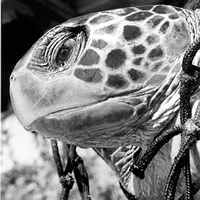California Wild: Turning Turtle
- wallacejnichols
- July 1, 2005
Wallace J. Nichols with Carl Safina

|
|
Turtles are placed in nets to be weighed, then released. The data help conservationists photo: teri garland |
Isidro Arce is a tall, quiet man. He speaks with the authority of one who knows he is right and who has his feet set firmly on the earth.
His friend, Javier Villavicencio, is not quiet. His words come at you fast and fill the air with passionate arguments: why we should have mercy for the animals, deep respect for the seas, and more care for our coastal waters.
Both men are leaders in the grassroots Grupo Tortuguero, a group of fishermen who monitor the turtle population at seven critical locations on the Baja California peninsula.
They harvest local fish and lobster yet work to prevent the extinction of the creatures inhabiting these waters.
Off Punta Abreojos
Twelve kilometers offshore of Punta Abreojos there is an underwater ridge at 40 fathoms. Isidro and I are in his fishing panga, floating above it. From here we drop a dozen traps baited with mackerel. When we’ve set the last trap, we return to the first and pull it up. The traps are already filled with verdillo, a medium-sized sea bass. Everything that is not verdillo or is undersized is thrown back. We repeat the circuit several times. Pull the trap. Add bait. Drop the trap.
We’ve had a good morning and reached our quota quickly.
Isidro says, “This area is very productive. We come out here to fish, to supplement our lobstering and abalone. It’s easy to catch fish, but we also take care of this reef.”
This means taking only the day’s limit of verdillo, lobster, or abalone; throwing back small fish and lobsters ready to lay; and leaving undersized abalone on the rocks to grow.
“If we do this now, we’ll always have something for the future. Our kids can live the way we live. And so can their kids.”
Isidro starts the motor and turns the boat towards the panga of a nearby comrade. We pull alongside.
“Que ondas, compa?”
“Nada, nada. Mas o menos,” comes the reply.
Isidro begins tossing our extra verdillo into the other panga so that his friend can go home to his family early.
This camaraderie and community cohesiveness is what keeps these waters productive. This past year the federation of fishing cooperatives that Punta Abreojos belongs to had its lobster catch certified “sustainable” by the Marine Stewardship Council—the first fishery in Latin America to earn this sought after eco-label.
Small fish, small lobster, small abalone—and the waters they live in— are guarded so that the animals will grow large enough to reproduce. So that the cold Pacific currents will run clean. So that there are fish, lobster, and abalone for people now and in the future.
Read full article here